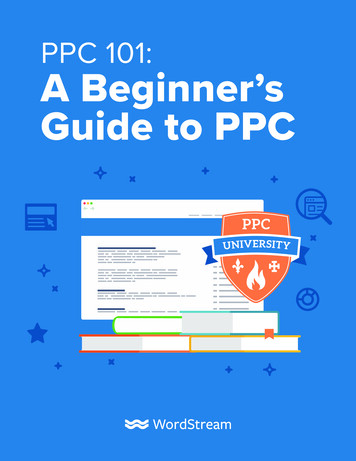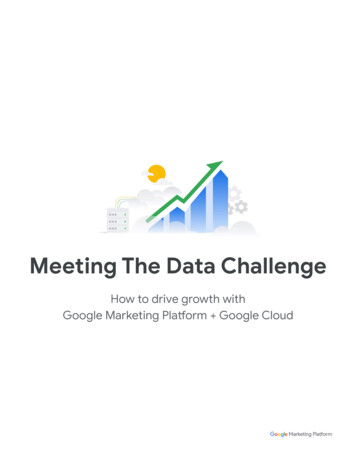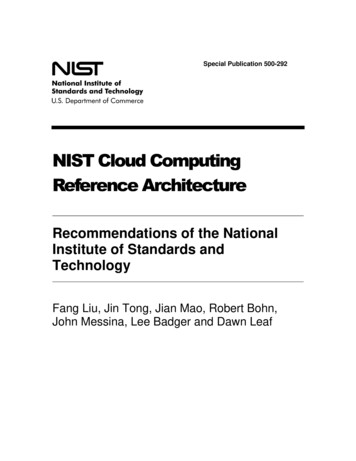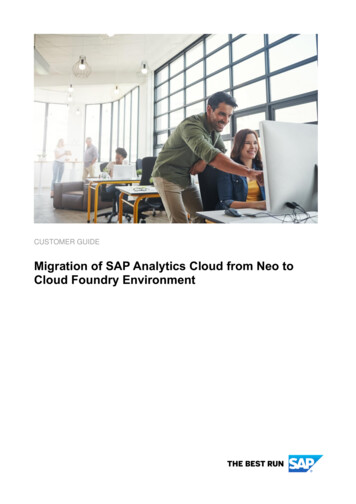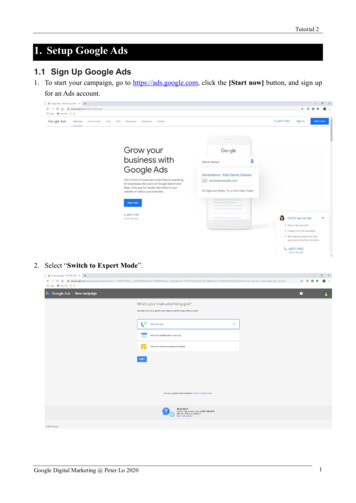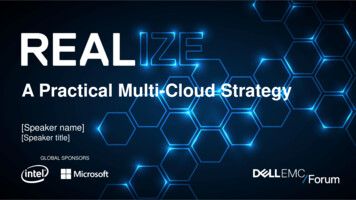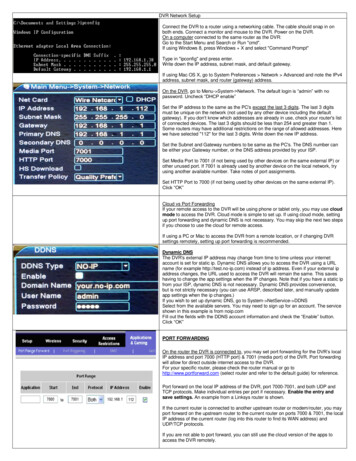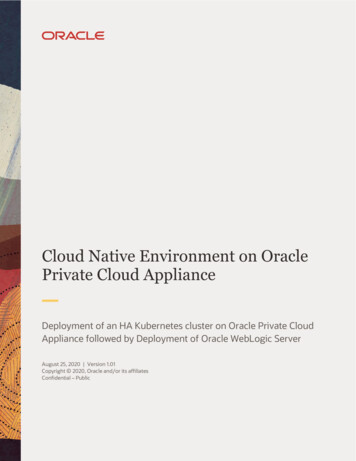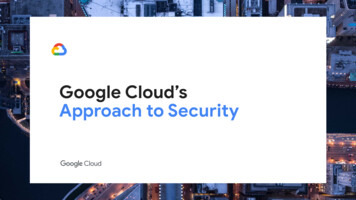
Transcription
Google Cloud’sApproach to Security
Table of ContentsOverview3Raising the Bar—Google Security Advances and Innovations6Secure by Design11Compliance and Trust21Conclusion262
Staying One Step Ahead.Protecting a global network against persistent and constantly evolving cyberthreats is one of the most important challenges we face. At Google, it’s all ina day’s work: data centers in the United States, South America, Europe, andAsia support billions of users in the public and private sectors.Google’s global network protects seven different global businesses, eachwith over 1 billion customers, including popular Google services such asGoogle Search, YouTube, Maps, and Gmail. We also work to protect the dataand operations of thousands of advertising and media companies that relyon Google’s ad products to run their business. Safeguarding our services,our infrastructure, and our users’ data is core to our continued success. Tostay ahead, we’ve not only adopted industry best practices, we’ve also led thetechnology industry in security by developing advanced tools and strategiesof our own.Our network communications protocols—the rules that enablecommunications between systems—change multiple times per second tomake malicious intrusions much harder. Data in Google Cloud is encryptedboth in transit and at rest. Google’s network capacity far exceeds anytraffic load we host, so if a distributed denial-of-service (DDoS) attack—where attackers try to shut down a service by flooding the network withtraffic—occurs, we can continue serving traffic while we work to isolate andshut down the source of the attack. Numerous other products, tools, andprocesses work to provide defense in depth.Our commitment to security underpins everything we do. It extends fromour platform and infrastructure to our software solutions and purpose-builthardware, and gives Google customers the assurance that their data andapplications meet security and compliance standards.This e-book provides a detailed overview of our approach to security andprivacy—so you have the data you need to trust us with your most importantdata and applications.3
Google Security by the Minute10 million694,0007,000spam messages are preventedfrom reaching Gmail customersindexed Web pages are scannedfor harmful softwaredeceitful URLs, files, and code inbrowser extensions are stopped6,0001,0002instances of unwanted softwareare reported to Chrome usersinstances of suspected malwareare reported to Chrome usersphishing sites and 1 malware siteare identified and mitigated
Research Spotlight:The Future of Securityin the Public CloudIn new research from McKinsey & Company, to which the Google Cloud securityteam contributed expertise, a majority of the 100 enterprise organizations surveyedexpect to double their public cloud adoption in the next three years—going from 19%of workloads to 38%. One organization predicted a future in which more than 90% ofworkloads have been migrated to the cloud.Another learning from the research: In a hybrid, multi-cloud world, organizations can’tsimply extend on-premises security controls to the public cloud, where configurationsand workflows are different. They need to work closely with cloud providers toimplement a shared, end-to-end security model.5
Raising the Bar
A SecurityObsessed CultureMore than 850 security professionals within Google monitor, design, research, andengage with the wider global community of Internet professionals and users. Theyuncover vulnerabilities, report software bugs to software vendors, and design newsecurity solutions and approaches.Security is incorporated into the entire software development process at Google.This includes analysis of architectures and code to uncover vulnerabilities andpotential attack models for a new product or feature. Our dedicated IncidentManagement Team ensures that any incidents that do arise are quickly addressed,analyzed, and remediated with minimal disruption to our customers.7
Threat Preventionand DetectionEffectively preventing cyber threats from impacting Google Cloudrequires vigilance, innovation, and agility—and sophisticated detectioncapabilities. Years of handling much of the Internet’s traffic, combinedwith investments in artificial intelligence, large data sets, and globalscale infrastructure, have all contributed to our success in continuallysafeguarding our network.Corporate customers benefit from our years of experience working to securedevices like Google Chromebooks. They were designed with many of the samesecurity principles that went into Google data centers. Features and practiceslike deep identity management, minimal data exposure, and centralized devicecontrol add up to a high level of threat prevention.Corporate webmasters and application developers get directnotification of malicious attacks, as well as diagnostic tools to monitortheir network. Google’s research into phishing attacks resulted in thedevelopment of security keys, small, easy-to-use hardware devices thatemploy public-key cryptography for strong authentication. They helpprotect user accounts across Google Cloud services, including bothGoogle Cloud Platform and G Suite.8
A Global SecurityPioneerPerfect ForwardSecrecyGoogle has published close to 300 papers on security, privacy,and abuse prevention. We have also distributed many tools forimproving software security industry-wide. Many of these tools,along with many more software applications, are released as opensource in order to support the community and encourage thehighest possible rate of innovation. We have donated more than20 different software projects to open source, promoting bettersecurity practices, and have fixed more than 100 security bugs inopen-source Linux and Chrome.Google is the first major cloud provider to enable perfect forward secrecy. Thisfeature provides a greater measure of protection for encrypted communications.It makes it more difficult for attackers to compromise secret keys or passwords.The service has been available since 2011 to users of Gmail, Google Docs, andencrypted Search.9
Rethinking SecureRemote AccessStrongerEncryptionA massive project at Google reimagined how we provide employeeswith secure remote access to applications. It resulted in BeyondCorp,Google’s innovative zero-trust security model. Instead of assuming aperson or a machine is inside or outside of the network, the model usescomputation to allow access to individual services as needed, based ontrusted identities and devices. Every day, thousands of our employeescan work securely with Google’s core infrastructure from any location.They do not use a traditional and less-secure VPN.To protect against threats to encryption techniques based on cryptographicadvances, in 2013 Google decided to double our RSA encryption key length to2048 bits. We also change our key every few weeks.In 2017, Google Trust Services was established to operate our own RootCertificate Authority to issue digital certificates. A digital certificate acts as atrusted third party to certify the ownership of a public key, part of the widelyused X.509 cryptography standard used in communications.Our zero-trust model is what allows Google employees to sign intoany laptop, from anywhere, with secure authentication tied to theuser instead of the network. It means work can happen anywhere,seamlessly and securely—powering higher levels of trust andproductivity. Administrators retain control of policies that determinewhich resources are authorized for use by whom.10
Secure by Design
Secureby DesignAt Google Cloud, we manage security throughout the data life cycle,from the data center to the device. Our customers extend their ownenterprise security measures into the cloud in a collaborative model.Google Cloud security uses a range of technologies, approaches,standards, and methodologies to protect applications, IT resources,and customer data.12
MultilayeredApproachFacility andHardware SecurityGoogle Cloud Platform’s infrastructure security is designed inprogressive layers—hardware, services, user identity, storage, internetcommunication, and operations. We call this defense in depth. Eachlayer has strict controls for access and privileges. From physical datacenter components to hardware provenance, secure boot, secureinter-service communication, secured data, and protected access toservices from the internet, Google Cloud’s approach to security is highlyeffective and continually evolving. Security layers are augmented bythe technologies and people processes Google deploys for operationalsecurity.Access to Google data centers is limited to a small number of specially qualifiedGoogle employees. We use multiple physical security layers to protect eachfloor. They include technologies like biometric identification, metal detectors,cameras, physical barriers, and laser-based intrusion detection.Our data centers have thousands of server machines connected to a localnetwork, providing an initial security layer. Both the server boards andnetworking equipment are custom-designed by Google to adhere to ourtough security requirements. We audit and validate the security properties ofcomponent vendor products we use. Google’s custom-designed chips includeTitan, a hardware security chip deployed on both servers and peripherals thatallows us to identify and authenticate legitimate Google devices at the hardwarelevel.13
Secure Boot Stack andMachine IDGoogle server machines use a variety of technologies to ensurethat they are booting the correct software stack. They are all built,controlled, and hardened by Google engineers and are continuallyevolving to enhance security. Automated systems ensure that serversrun up-to-date software versions, including security patches, todiagnose hardware and software problems and remove machinesfrom service if necessary.Each server machine has its own specific identity that can be tied tothe hardware root of trust and the software booted by the machine. Soevery time a machine communicates with the Google Cloud network,its individual identity is verified.14
Service Identity, Integrity,and IsolationGoogle Cloud uses sophisticated techniques like cryptographicauthentication and authorization at the application layer for servicessuch as computing, data storage, data analytics, and machine learning.This means that services may be run on thousands of machines tohandle the required scale of the workload, and that they are controlledby a cluster orchestration service to be optimally efficient and availablewhen you need them.Internal network segmentation—restricting infrastructure use to onlythose network assets required to perform a particular job—and theuse of specialized security appliances like firewalls are not the primarysecurity mechanisms used on Google Cloud Platform, althoughingress and egress filtering are used to prevent IP spoofing. Traditionalperimeter security, with its intrinsic trust of everyone inside, is lesseffective in companies where employees work both onsite and offsite. Toallow work to happen anywhere, anytime, we take a different approach.Each service has an associated service account identity and is providedwith cryptographic credentials, used by servers and clients, that are usedto prove its identity. Google source code—the fundamental softwareprograms behind our many solutions—is stored in a central repositorywhere all versions are auditable.15
Inter-Service AccessManagementGoogle Cloud customers using specific services from the platform cancustomize and manage them. Using a console, they can specify andrestrict what other services can communicate with their services. Forexample, using application programming interfaces (APIs), an analyticsback-end applications can be added to an enterprise resource planning(ERP) app. Or the APIs can be used to allow access to the service onlyfor certain users based on their account identities.Google engineers are also issued individual identities, so services canbe configured to allow or deny them access. The infrastructure alsoprovides services the ability to read from central access control list(ACL) and group databases, which verify user and access privilegesthrough still other security measures.Our software runs in Google’s containers, a resource-efficient techniquefor deploying applications from within an operating system withoutthe need to launch virtual machines. Aside from resource efficiency,containers enable system-wide management and lightning-fast systemaudits. Configuration changes and security patches can be deployedeverywhere, quickly, with minimal downtime. We offer our customersan open-source version of these containers called Kubernetes. Usingcontainers, you can quickly access secure and sensitive data logsrequired in compliance audits. This used to take days; now it’s done inminutes.16
Encryption of Inter-ServiceCommunicationOur infrastructure also provides cryptographic privacy and integrity for remote procedurecall (RPC) data over the WAN between data centers. RPCs are communications betweenprograms on different networks that request services. To protect against sophisticatedadversaries who may be trying to tap our private WAN links, the infrastructureautomatically encrypts all infrastructure RPC traffic.Cryptography is the science of using math to encrypt and decrypt data. At Google, weuse it to ensure that RPC data moving on the network is private, unchanged by any thirdparty, and is being exchanged between trusted partners. These cryptographic featuresare encapsulated inside of the the Google Cloud RPC mechanisms so they are availableto other application-layer protocols such as HTTP. This provides application-layerisolation and removes dependency on the security of the network path. Encrypted interservice communication can remain secure even if the network is tapped or a networkdevice is compromised.17
Access Managementand Transparency ofEnd User DataSecure DataStorageGoogle Cloud’s infrastructure provides a central user identity servicethat issues end user permission tickets as part of the RPC. The ticketsprove that a service is responding to a request on behalf of a particularend user.The various Google storage services can be configured to use keys from aAn end user login is verified by the central identity service, which thenissues a user credential (such as a cookie or OAuth token) to the user’sclient devices. Every subsequent request from the client devices intoGoogle Cloud needs to present that user credential.malicious disk firmware. Other layers of protection are also used, such ascentral key management service to encrypt data before it is written to physicalstorage. Performing encryption at the application layer allows the infrastructureto isolate itself from potential threats at the lower levels of storage such ashardware encryption.In 2017, Google partnered with SAP to implement a joint data custodianmodel. The model offers SAP as custodian of customer data on GoogleCloud, with continuous monitoring for compliance, based on definedcontrols.18
Secure InternetCommunicationGoogle Cloud secures communication between the internet and GoogleCloud services. We isolate our infrastructure into a private IP space,exposing only a subset of machines directly to external internet trafficand DDoS attacks. Other features, like Google Cloud Armor—availablewith the use of Cloud Load Balancer—are used to provide DDoSprotection at the network edge, closer to the origination of attacks.The Google Front End (GFE) services ensure that all transport layersecurity (TLS) connections are terminated using correct certificates andfollow best practices. The GFE also provides protections against DDoSattacks. Here’s how it works: Load balancers report information aboutincoming traffic to a central DDoS service. If it detects that a DDoSattack is occurring, it can configure the load balances to drop or throttlethe traffic. The GFE layer also reports information about DDoS, includingapplication layer information, and the GFE can also be configured todrop or throttle traffic if a DDoS attack is detected.Our central identity service, which users see as the Google login page,asks for a username and password, and assesses risk factors such aswhether users have logged in from the same device or location in thepast. The service issues credentials such as cookies and OAuth tokens.Second factors, such as one-time passwords or phishing-resistantsecurity keys, may also be used by users when signing in.19
OperationalSecurityOur security teams triage, investigate, and respond to incidents 24hours a day, 365 days a year. We conduct regular exercises to measureand improve security detection and response. Google Cloud provideslibraries and frameworks that prevent developers from introducingcertain classes of security bugs, like XSS vulnerabilities in web apps.Automated tools are available to detect security bugs, includingfuzzers, static analysis tools, and web security scanners. Manualsecurity reviews are also used. Conducting these efforts manually onan ongoing basis would be cost-prohibitive and time-consuming to atypical enterprise organization.policies for physical, computer, data, and network security; accessmanagement; security logging; and more. We also monitor activity todiscover potential compromises and illicit insider activity. Applicationlevel access management controls expose internal applications onlyto specific users. Administrative access privileges are limited andmonitored. And sophisticated intrusion detection utilizes host-basedsignals on individual devices, network-based signals from variousmonitoring points, and signals from infrastructure services.Google makes a heavy investment in protecting our employees’ devicesand credentials from compromise using technologies and strict20
Complianceand Trust
Meeting GlobalSecurity StandardsAs a global network, Google adopts the network, data, privacy, andoperational policies set by nations where we operate so Google Cloudcustomers can meet policy, regulatory, and business requirements andcompliance mandates. We follow industry standards, including thoseof the International Organization for Standardization (ISO), the AmericanInstitute of Certified Public Accountants (AICPA) Service OrganizationControls (SOC) 2 and 3; the Payment Card Industry Data SecurityStandard (PCI DSS); the National Institute of Standards and Technology(NIST); and many others.22
Meeting RigorousPrivacy and ComplianceStandardsTrust-FirstApproachGoogle Cloud is committed to complying with the European Union’sThe Google Cloud Trust Principles summarize our commitments to protecting theGeneral Data Protection Regulation (GDPR). GDPR strengthensthe rights of individuals over their personal data and seeks to unifydata protection laws across Europe. Additionally, Google Cloud hasproduced documentation as to how we adhere to the Australian PrivacyPrinciples (APPs) and Australian Prudential Regulation Authority (APRA)privacy of customer data. The customer—not Google—owns their data. You decidehow it resides in Google Cloud, applying factors such as data segregation, controlsby region, key encryption, and revocation. And if you choose to stop using GoogleCloud, you can take your data with you at any time.Standards, the Japan Center for Financial Industry Information Systems(FISC) guidelines, the Multi-Tier Cloud Security (MTCS) SingaporeStandard (SS) 584, the Spain Esquema Nacional de Seguridad (ENS)accreditation scheme, and the UK NCSC Cloud Security Principles.23
Going Beyond EnterpriseProtectionsThe scale of Google Cloud operations and our collaboration with thesecurity research community let us either address vulnerabilities quicklyor prevent them proactively. By extending their own enterprise securitymeasures into Google Cloud in a collaborative partnership model, ourcustomers not only gain protection, they can generate new revenue byoffering new services and business models.London-based financial technology company Ravelin has become amajor player in online fraud prevention through the use of the artificialintelligence technique called machine learning. Google Cloud’scommitment to open source technology allowed Ravelin to migrate itsentire infrastructure onto the Google Cloud Platform. Google Cloud’sstrong security and cutting-edge encryption allow Ravelin to moresafely store and analyze credit card details, location data, and personalidentifiable information for its clients, in compliance with ISO/IEC27001 and Payment Card Industry Data Security Standards (PCI DSS).Ravelin’s anti-fraud machine learning model processes transactionswithin 300 milliseconds. As of 2017, the company has stopped over 100 million of fraudulent transactions and analyzed over 12 petabytesof data over a three-year period.24
A GloballyDistributed NetworkGoogle provides services that can be accessed by millions of users no matterwhere they are. Google Cloud services operate globally, using a geographicallydistributed infrastructure to help ensure that the services that run on themhave maximum availability and uptime. Data typically no longer resides ona single hard drive or server rack, or even in a single data center. Instead, itmust be stored, secured, and made available so it can be accessed by theusers who depend on it in India or Oklahoma just as easily as in New York orGermany. This dependable, 24/7 availability, along with Google Cloud security,best practices for secure data handling, and adherence to compliancemandates, are behind the growing popularity of Google Cloud amongenterprise organizations worldwide.25
Three Tenetsof Google CloudWe protect your business through a collaborativeYou maintain control over your data, with theWe work hard to meet global security standardsprocess designed to help you make the rightpower to determine how it is collected and usedthat support compliance with internal policiespeople, process, and technology adjustmentsby providers, employees, and your customers.and external regulations that may be requiredto keep up with new threats and securityGoogle Cloud is committed to providingby your organization. This includes how datachallenges. By choosing to work with the cloudcustomers with data transparency and controlsis collected, used, and accessed. The richbuilt on the world’s largest computing networkto manage access. Google’s international securityset of controls and capabilities supported byinfrastructure, your organization will gain accessand privacy standards are certified and validatedGoogle Cloud continues to grow over time.to our expertise, our experience, and the agility toby independent auditors. And Google Cloud doesThis includes SSAE 16/ISAE 3402 Type II, ISOaddress the threats of today and tomorrow. As anot and will not sell any customer data, ever.27001/27017/27018, FedRAMP, PCI DSS, HIPAA,Google Cloud customer, you’ll get to use the sameCSA STAR, MTCS Tier 3, GDPR (Europe), NISTinfrastructure that has propelled and sustained800-171/800-53, FISC (Japan), MPAA, SOX,Google, including the power of machine learning,Australian Privacy Act and APPs, APRA Standards,AI, and IoT.and ENC (Spain).27
For more information, visit our website tolearn more about our security approach.
Google Cloud security uses a range of technologies, approaches, standards, and methodologies to protect applications, IT resources, and customer data. Secure by Design. 13 Google Cloud Platform’s infrastructure security is designed in progressive la
